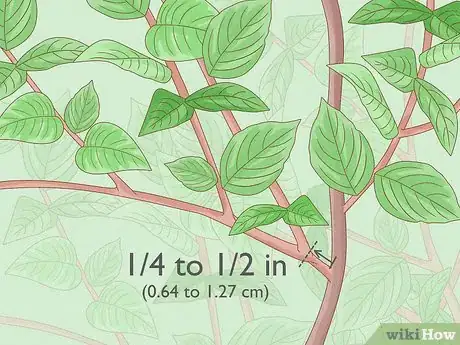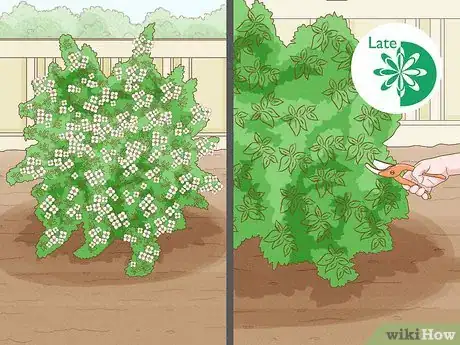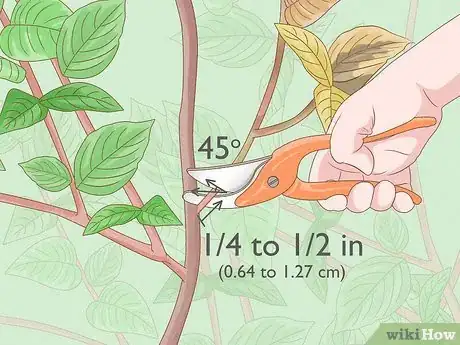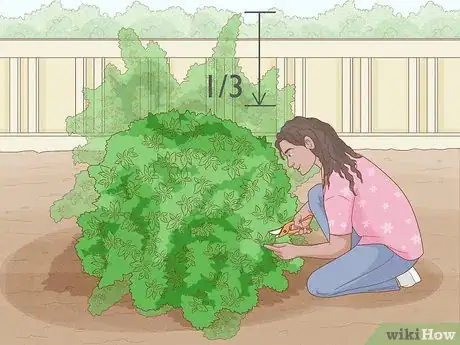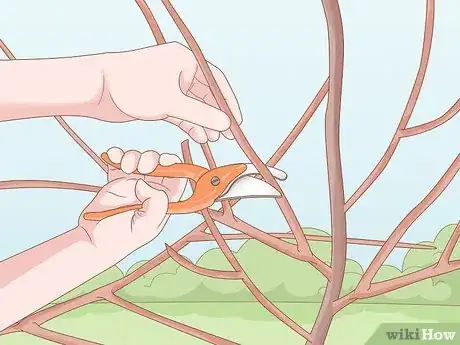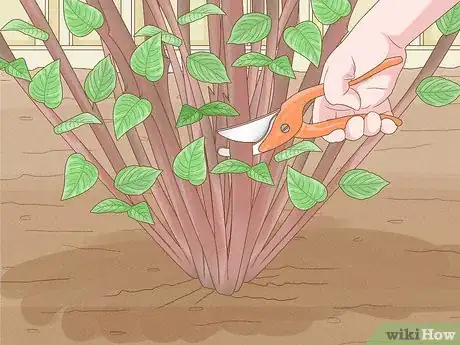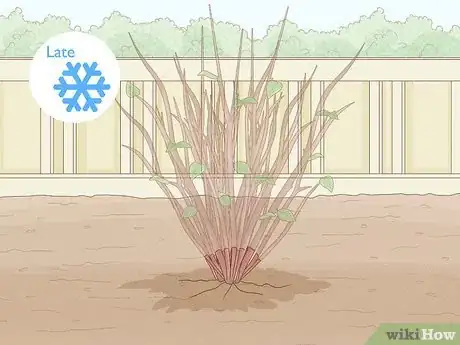This article was co-authored by Maggie Moran. Maggie Moran is a Professional Gardener in Pennsylvania.
There are 9 references cited in this article, which can be found at the bottom of the page.
This article has been viewed 47,899 times.
Mock orange shrubs are easy to care for and produce lovely, fragrant blooms. They benefit from annual pruning once they reach maturity or 3 or 4 years after planting. After the flowers fade, thin out the top stems and remove 20 to 30% of the main branches. For an overgrown, neglected shrub, your best option might be coppicing, or cutting back all of the branches to ground level. It might sound drastic, but mock orange shrubs usually recover fully within 1 to 2 years.
Steps
Mastering Basic Pruning Techniques
-
1Use sharp pruning shears and loppers instead of hedge shears. If you use hand-held pruning shears and long lopping shears, you can cut branches and stems selectively. That way, you’ll be able to manage your shrubs’ growth strategically.[1]
- Because they cut indiscriminately, hedge shears create multiple growing points. This results in top-heavy shrubs with dense outer growth, which kills the foliage in the interior of the plant.
- Use loppers to cut canes, or the larger branches that grow from the ground. Clip branches that are thinner than 1 1⁄2 in (3.8 cm) with hand-held pruners.
- Wear gardening gloves to protect your hands and get a better grip on your cutting tools.
-
2Sanitize your shears with rubbing alcohol. Clean shears will promote healing and minimize the risk of spreading disease. Wipe down the blades with a clean cloth or paper towel dipped in rubbing alcohol that’s at least 70% pure. The shears will quickly dry, so there’s no need to wipe them again with another cloth.[2]
- Sanitizing your tools is especially important if you've just taken them out of winter storage.
- Clean your tools after pruning a diseased tree and when you’re finished pruning everything.
Advertisement -
3Trim stems about 1⁄4 to 1⁄2 in (0.64 to 1.27 cm) from the main branch. If you clip a stem too close to the main branch, you’ll risk damaging the tissues that heal the cut. On the other hand, if you leave too long of a stub, the cut will heal slowly. Aim for a sweet spot between 1⁄4 and 1⁄2 in (0.64 and 1.27 cm) from the main branch.[3]
-
4Make your cuts at 45-degree angles. Hold your shears at an angle, whether you're cutting thick branches with a lopper or thin growth with hand-held pruners. The 45-degree angle will make it easier to cut cleanly, promote healing, and minimize the risk of rot.[4]
- Additionally, cut at an angle away from the crotch, or where a stem meets the main branch. That way, if you slip, you won’t drive the blade into the main branch and injure it.
Pruning Your Shrubs Annually
-
1Prune mock orange shrubs after they’ve finished flowering. The flowers of mock orange shrubs bloom on old wood, or the growth that develops in the summer, fall, and spring prior to flowering. Pruning your shrubs immediately after their flowers fade will maximize their growing time, resulting in more blooms next growing season.[5]
- Mock orange shrubs finish blooming by late spring. If you prune in the early spring before your shrubs bloom, you'll cut off the buds that will grow into flowers.
- There’s usually no need to prune mock orange shrubs until their third or fourth year.
-
2Start by removing dead, damaged, or twiggy shoots. Look for stems without leaves, that are broken, or that have any blemishes or unusual growths. Trim dead or twiggy shoots that sprout from the ground to the crown, or just above ground level. If they grow from another branch, clip them to their point of origin on the main branch.[6]
- Remember to clip stems at a 45-degree angle about 1⁄4 to 1⁄2 in (0.64 to 1.27 cm) from the main branch. For dead or twiggy shoots that sprout from the ground, trim them about 1⁄4 to 1⁄2 in (0.64 to 1.27 cm) from where they emerge from the ground.
- Dead or damaged stems might harbor disease, so sanitize your shears after clipping them.
-
3Trim about one-fifth to one-third of the canes to the ground. Find the tallest canes, or the main branches that grow from the ground. Trace the tallest one down to the crown, then use your loppers to cut it back to ground level. Pull the pruned cane out from the shrub, then cut it up so it fits in a lawn bag or in your compost heap.[7]
- Prune around 20 to 30% of the canes to control the shrub’s growth and to give the interior leaves access to sunlight.
- Tying ribbons around the canes you want to cut can help you prune the shrub evenly.[8]
-
4Train your shrub by thinning the remaining canes. After removing the tallest canes, check the top of the shrub for uneven shoots, or stems that are taller than the surrounding foliage. Shape the shrub by clipping the tallest remaining stems just above the point where another shoot sprouts from the branch. This will encourage horizontal growth and result in a fuller, more attractive shrub.[9]
- For instance, suppose you want to remove about 6 in (15 cm) of growth at the top of a branch. Trace the cane you want to clip down to a point where a stem emerges from the main branch. Clip the main branch 1⁄4 to 1⁄2 in (0.64 to 1.27 cm) above the point where the stem emerges.
- Clip taller stems until the shrub’s height is roughly even. The shrub should still look natural, so don’t try to make the top perfectly flat like a formally manicured hedge.
Coppicing a Tangled Shrub
-
1Rejuvenate an overgrown, neglected shrub with sparse foliage. If your shrub is old, has thick branches without leaves, or doesn’t produce flowers, your best option is probably the rejuvenation method. Rejuvenation pruning, or coppicing, involves cutting all of the canes down to the crown to encourage new growth.[10]
- While it might seem drastic, mock orange shrubs usually tolerate coppicing. Within a year, your shrub should grow back to a more attractive size and shape.
-
2Coppice your shrub in late winter to increase its chances of recovering. Mock orange shrubs go dormant in the winter, and you won’t shock the plant as much if you coppice during dormancy. While you could try to rejuvenate it immediately after its flowers fade, there’s a higher risk that it won’t recover.[11]
- Keep in mind the flowers of mock orange shrubs bloom on old wood. If you coppice in the winter, your shrub won’t bloom the following growing season.
-
3Cut the canes to 4 to 6 in (10 to 15 cm) above ground level. The technique is similar to annual renewal pruning, but you’ll cut back all of the canes instead of one-third of them. Use your lopping shears to cut each cane down to a few inches above the crown.[12]
- When you’re finished, cut the canes up so they’ll fit in a lawn bag or in your compost heap.
-
4Fertilize your shrub in the early spring after coppicing. If you coppice in winter, your shrub is dormant and doesn't need any attention until spring. In the early spring, begin watering whenever the soil dries out, and apply a liquid fertilizer. It’s wise to test your soil so you know exactly what nutrients to provide.
- For example, suppose your soil has lots of phosphorus (P) and potassium (K), but is low in nitrogen (N). You’d check the N-P-K ratios on fertilizer labels, and go with a product with a higher N value, such as 14-7-7.
- If you don't need to correct a nutrient deficiency, choose a fertilizer labeled for shrubs and trees with an N-P-K ratio of 3-1-2 or 3-1-1, such as 15-5-10 or 15-5-5.[13]
- Apply fertilizer at the start of the growing season according to your product’s instructions. As a rule of thumb, apply about 4 fl oz (120 mL) of liquid fertilizer diluted in 1 US gal (3.8 L) of water.
- To meet your recovering shrub’s high nutrient needs, add well-matured compost or a slow-release pellet fertilizer in late spring or early summer.
-
5Allow at least 1 growing season for your shrub to recover. If you coppiced in late winter, you won’t see blooms that growing season. However, you’ll see foliage sprout, and the shrub should bloom the following year.
- Your shrub probably won’t need significant pruning for 3 or 4 years after coppicing. You can shape it by thinning out the top growth after the flowers fade, but you won’t remove any canes for the first few years.
Expert Q&A
Did you know you can get expert answers for this article?
Unlock expert answers by supporting wikiHow
-
QuestionCan weigela be cut back?
 Maggie MoranMaggie Moran is a Professional Gardener in Pennsylvania.
Maggie MoranMaggie Moran is a Professional Gardener in Pennsylvania.
Home & Garden Specialist
-
QuestionCan you cut back Choisya?
 Maggie MoranMaggie Moran is a Professional Gardener in Pennsylvania.
Maggie MoranMaggie Moran is a Professional Gardener in Pennsylvania.
Home & Garden Specialist
-
QuestionWhen should I cut back Hebe?
 Maggie MoranMaggie Moran is a Professional Gardener in Pennsylvania.
Maggie MoranMaggie Moran is a Professional Gardener in Pennsylvania.
Home & Garden Specialist
Things You’ll Need
- Hand pruning shears
- Lopping pruning shears
- Rubbing alcohol, at least 70% pure
- Gardening gloves
Warnings
- Use caution when using pruning shears and other sharp tools.⧼thumbs_response⧽
References
- ↑ http://web.extension.illinois.edu/cfiv/homeowners/030524.html
- ↑ http://gardeningsolutions.ifas.ufl.edu/care/tools-and-equipment/disinfecting-tools.html
- ↑ http://extension.uga.edu/publications/detail.html?number=B949&title=Basic%20Principles%20of%20Pruning%20Woody%20Plants
- ↑ https://aggie-horticulture.tamu.edu/earthkind/landscape/proper-pruning-techniques/
- ↑ https://www.rhs.org.uk/advice/profile?PID=197
- ↑ https://www.rhs.org.uk/advice/profile?PID=197
- ↑ https://www.youtube.com/watch?v=LSxO1PCcH8s&feature=youtu.be&t=90
- ↑ http://web.extension.illinois.edu/cfiv/homeowners/030524.html
- ↑ https://www.youtube.com/watch?v=LSxO1PCcH8s&feature=youtu.be&t=250
About This Article
Mock orange shrubs are easy to care for, but you’ll need to start pruning them 3 or 4 years after planting. Prune your shrub immediately after its flowers fade to maximize growing time, which will increase the number of blooms you get the following year. Remove any branches that are broken, damaged, or have no leaves with loppers or long shears. Avoid using hedge shears, because they cut branches indiscriminately. Make each cut about 1/4 inch from the bottom of the stem, which will help promote healing. You should also trim between 1/3 and 1/5 of the vertically-growing canes to ground level so that the remaining growth can get sunlight. To shape your shrub, trim off any uneven shoots that are taller than the surrounding foliage to promote neat growth. Remember to make all of your cuts at a 45-degree angle to reduce damage and guard against rot. For tips from our Gardening co-author on how to prune an overgrown shrub, keep reading!


